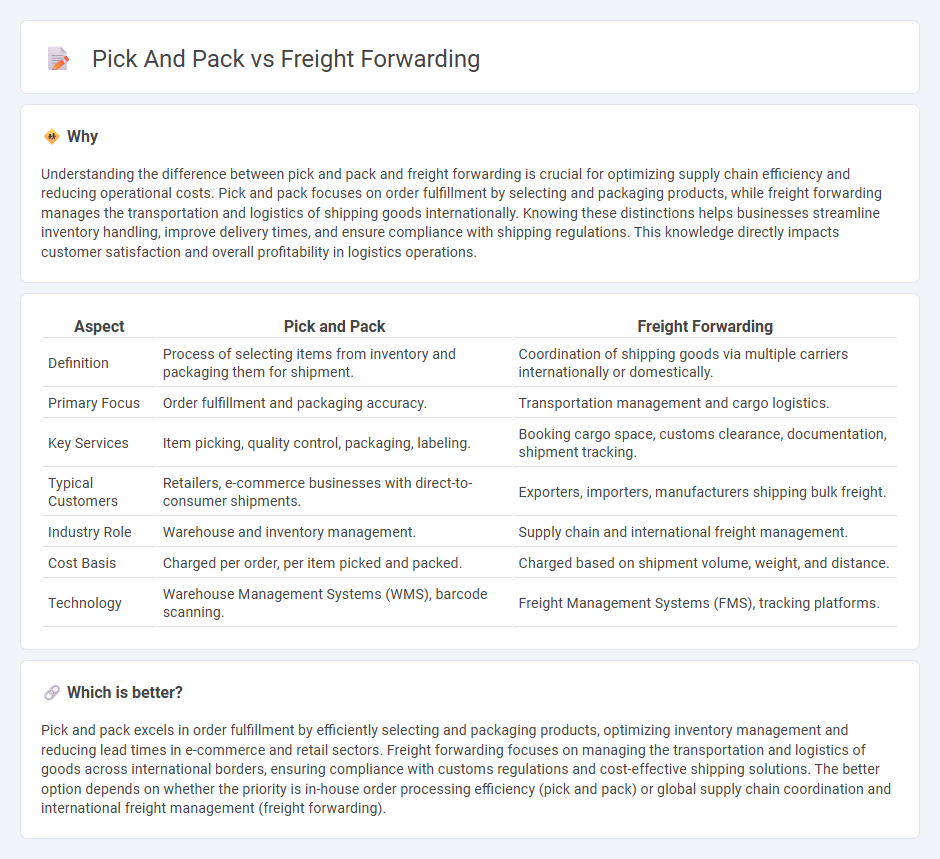
Pick and pack involves selecting individual items from inventory and packaging them for shipment, optimizing order accuracy and delivery speed for e-commerce and retail businesses. Freight forwarding coordinates international transportation by managing logistics, customs documentation, and carrier selection, ensuring efficient movement of large shipments across borders. Explore the key differences and benefits of pick and pack versus freight forwarding to streamline your supply chain.
Why it is important
Understanding the difference between pick and pack and freight forwarding is crucial for optimizing supply chain efficiency and reducing operational costs. Pick and pack focuses on order fulfillment by selecting and packaging products, while freight forwarding manages the transportation and logistics of shipping goods internationally. Knowing these distinctions helps businesses streamline inventory handling, improve delivery times, and ensure compliance with shipping regulations. This knowledge directly impacts customer satisfaction and overall profitability in logistics operations.
Comparison Table
| Aspect | Pick and Pack | Freight Forwarding |
|---|---|---|
| Definition | Process of selecting items from inventory and packaging them for shipment. | Coordination of shipping goods via multiple carriers internationally or domestically. |
| Primary Focus | Order fulfillment and packaging accuracy. | Transportation management and cargo logistics. |
| Key Services | Item picking, quality control, packaging, labeling. | Booking cargo space, customs clearance, documentation, shipment tracking. |
| Typical Customers | Retailers, e-commerce businesses with direct-to-consumer shipments. | Exporters, importers, manufacturers shipping bulk freight. |
| Industry Role | Warehouse and inventory management. | Supply chain and international freight management. |
| Cost Basis | Charged per order, per item picked and packed. | Charged based on shipment volume, weight, and distance. |
| Technology | Warehouse Management Systems (WMS), barcode scanning. | Freight Management Systems (FMS), tracking platforms. |
Which is better?
Pick and pack excels in order fulfillment by efficiently selecting and packaging products, optimizing inventory management and reducing lead times in e-commerce and retail sectors. Freight forwarding focuses on managing the transportation and logistics of goods across international borders, ensuring compliance with customs regulations and cost-effective shipping solutions. The better option depends on whether the priority is in-house order processing efficiency (pick and pack) or global supply chain coordination and international freight management (freight forwarding).
Connection
Pick and pack processes streamline order fulfillment by selecting and packaging products for shipment, directly impacting freight forwarding efficiency. Accurate pick and pack operations reduce errors and delays, enabling freight forwarders to consolidate shipments and optimize transportation routes. Seamless integration between pick and pack systems and freight forwarding ensures faster delivery times and lower logistics costs.
Key Terms
**Freight Forwarding:**
Freight forwarding involves coordinating the shipment of goods from the manufacturer to the final destination, including customs clearance, documentation, and transportation logistics across multiple carriers and modes of transport. This service optimizes supply chain efficiency by managing complex international shipping requirements and minimizing delays. Explore more about how freight forwarding can enhance your global logistics strategy.
Customs Clearance
Freight forwarding involves managing the entire shipping process, including customs clearance, ensuring compliance with import/export regulations, and handling documentation to avoid delays and penalties. Pick and pack services focus on warehousing and packaging orders efficiently but typically do not manage customs clearance or international shipping requirements. Explore the key differences and how customs clearance impacts each process to optimize your logistics strategy.
Bill of Lading
The Bill of Lading is a critical document in freight forwarding, serving as a receipt of goods, a contract of carriage, and a document of title, ensuring smooth international shipping processes. In contrast, pick and pack services focus on the accurate selection and packaging of orders without directly involving the Bill of Lading, which is not typically part of their operations. Explore detailed distinctions and roles of the Bill of Lading in logistics to optimize your supply chain management.
Source and External Links
What is freight forwarding? | Clarksons - Freight forwarding is the strategic planning and coordination of the international movement of goods via various transport modes, with freight forwarders managing logistics, customs clearance, storage, and routing to ensure timely and safe delivery of cargo on behalf of importers/exporters.
What Is Freight Forwarding? Definition, Benefits and Key Stages - Freight forwarding involves multiple stages such as export haulage, customs clearance, origin handling, and ensuring compliance with regulations on hazardous, perishable, or restricted goods to facilitate international shipments efficiently.
About Freight Forwarding - FIATA - Freight forwarding entails services relating to the carriage, consolidation, storage, handling, packing, and distribution of goods, including customs, insurance, and supply chain management, to ensure goods reach the right place, time, condition, and cost-effectively in international trade.
 dowidth.com
dowidth.com